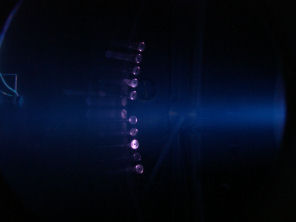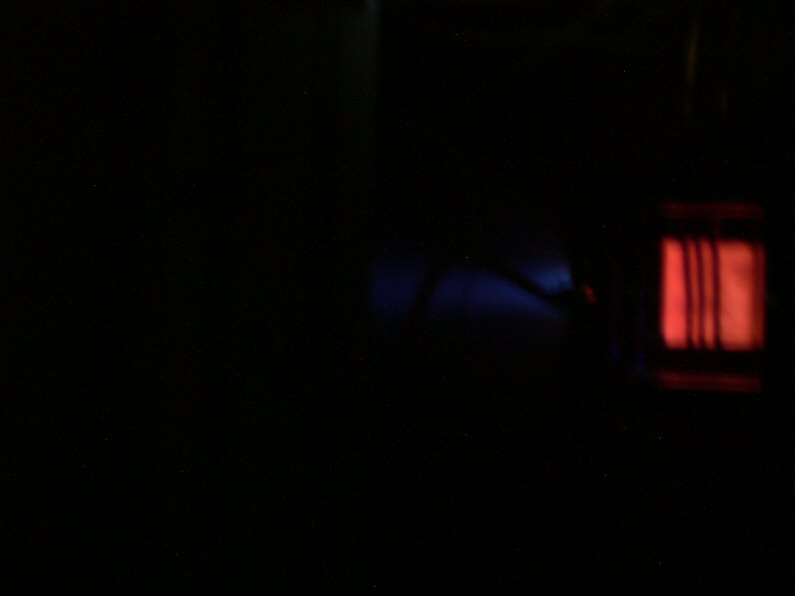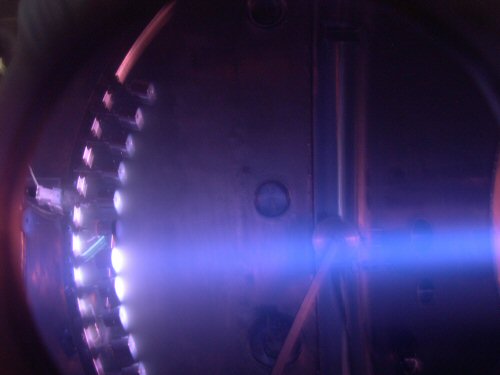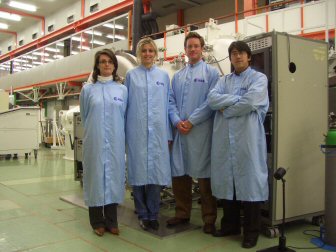The DS4G Test Diaries: Week 3 (by Christina Bramanti)
Monday, 15th May 2006

Today our efforts were concentrated on finding the right parameters (mass flow, RF power and extraction potential) in order to sustain the beam for longer time and reach stable conditions. We performed many attempts and at the end of the day, after evaluating each test result carefully, we were able to sustain the beam for 1 minute in stable conditions.
The Faraday Cup, mounted inside CORONA main chamber, was able to provide the first promising results about the DS4G beam!!! It has been specifically designed and manufactured by the ESTEC workshop (great support for me) with the other ACT diagnostics instruments (Langmuir probe and calorimeter) during the last months for measuring the characteristics of the DS4G beam.
Tuesday 16th May 2006
In the morning, we started by analysing and evaluating the results from the pasts days. Remembering also the lessons learned from the first test phase, we defined the strategy and the test plan.
In the morning, after few attempts, we were able to reach stable conditions for few minutes at 10KV and and low RF power!!!!!!!!!!!!!
We were very happy to see a stable blue beam coming out from the thruster.
In the afternoon we started the next effort: increasing the RF power and reach higher thruster efficiency, keeping the voltages constant on the first two grids (that is same extraction potential). We played with the parameters and tried to evaluate their interdependency. We performed several tests and several diagnostics scans through the CORONA movable arms, where the Faraday cup, the Langmuir probe and the calorimeter are mounted.
At the end of the day we saw something flashing inside the chamber. We saw that the cause was a resistor connected to the RF system. We decided to vent the CORONA hatch and to check the status of the resistor.
Wednesday 17th May 2006
Today was again a long day...
In the morning....
We checked the status of the resistor connected with the RF system. It was completely dead!!! We substituted it. We realized that it might have been also one of the possible cause of the arching events that we were detecting during the experimental tests during the last few days.
We inserted a teflon reservoir in the feeding line to check if we were able to increase the duration of the test at lower mass flow rate.
We carried out a high voltage breakdown test at atmosphere pressure to check that the addition of the reservoir didn't cause any problems of arcing. We didn't see any arcing event.
We pumped down again.
In the afternoon...
We also performed a high voltage breakdown test in vacuum.
We started the experimental tests again.
The substitution of the resistor was successful and we didn't see anymore frequent arcing events during the beam extraction.
The introduction of the reservoir led to a very great result; we were able to perform few tests at 10kV (applied on the 1st grid) with a duration of more than 10 minutes each in stable conditions. We were able to maintain a mass utilization efficiency up to 90% and an electrical efficiency of up to 60% with an overall efficiency up to 54% (in line with the state of art of conventional ion engines). The beam divergence measured with the Faraday cup was few deg.
Tomorrow we will start to reach 15kV...
Thursday 18th May 2006
Today Dave Fearn, who proposed the concept in 2001, was visiting us again. It is always very nice to have Dave around, he has really a positive and optimistic behaviour.
In the early morning, we decided the test plan and defined the test objectives.
We performed several tests at 10KV for different flow rates and RF power. We tried to optimise the extraction potential between the first two grids. Once evaluated the optimum condition, we carried out several tests trying to maintain the mass utilization efficiency up to 85% in stable conditions. We obtain stable conditions and we were able to perform several scan with the diagnostics. We reached an overall efficiency of up to 65%.
In the afternoon, we performed several tests at 15KV. We obtained great results and the beam was extremely stable and long in duration (up to 15 minutes). The overall efficiency was again up to 65%. That is a very great achievement and meets all the objectives of the tests.
As the day was very successful so far, we thought that to conclude the day's work, we should try to increase the voltage up to 17.5kV. The beam was extremely stable and very narrow. We were able to maintain the overall efficiency up to 65% (mass utilization efficiency up to 90%) for up to 15 minutes!!!
We were very happy and motivated for tomorrow...
Friday, 19th May 2006
After the interesting results of the past two days we wanted to validate the results with further experiments in the same conditions and additional diagnostics scans. The results were compliant with the ones obtained in the past days.
In the afternoon, we performed additional tests. At 15kV, we increased gradually the mass flow and the RF power, in order to extract more current, but maintaining the mass utilization efficiency up to 90%.
We reached, at 15kV:
- Thrust up to 5mN.
- Specific impulse up to 13000.
- Overall efficiency up to 65%.
- Beam divergence up to 5 deg.
Photos


